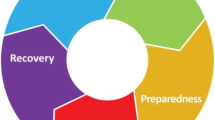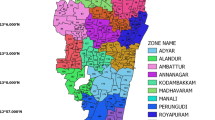Abstract
Social media plays an important role in disseminating spontaneous information during natural disasters/emergencies. It is a crowdsourcing platform, capable of complementing and supplementing remote sensing data in disaster mapping. Continuous monitoring of disasters such as floods from pre-stage to post stage is essential and geo-social media can attain it. The present research proposes a robust architecture to develop a social media-based near-real time flood monitoring system. In addition, our research article also emphasizes the efficient methods to process, analyse and explore multiple data dimensions of social media. A prototype model was prepared and tested on the tweets of Chennai floods 2015 to demonstrate social media potential in disaster monitoring. We implemented Natural Language Processing and Supervised Machine Learning in data processing and analysis segments of the framework by assembling various open source python libraries to develop the prototype. Initially, we built the required tweet corpus and performed pre-processing steps on it. Later, the collected tweets were geocoded with the place names available in the tweets and classified them into various flood topic related classes using Naive Bayes classifier. Subsequently, the tweets showcasing the flood condition were determined to generate a point map and a point density map to identify the flood hotspots. We verified our results with openly available 2015 Chennai flood map that is generated using remote sensing images and found positive outcome. A prototype web portal was developed to publish the results from above model as web maps. Furthermore, the portal would prove to be useful as a source for disseminating information to the public. The results prove that the proposed framework is evidently supportive in establishing a near real time monitoring system during emergencies.








Similar content being viewed by others
References
Bird, S., Klein, E., & Loper, E. (2009). Natural language toolkit. O’Reilly Media.
de Albuquerque, J. P., Herfort, B., Brenning, A., & Zipf, A. (2015). A geographic approach for combining social media and authoritative data towards identifying useful information for disaster management. International Journal of Geographical Information Science., 29(4), 667–689.
Eilander, D., Trambauer, P., Wagemaker, J., & van Loenen, A. (2016). Harvesting social media for generation of near real-time flood maps. Procedia Engineering., 154, 176–183.
Fang, J., Hu, J., Shi, X., & Zhao, L. (2019). Assessing disaster impacts and response using social media data in China: A case study of 2016 Wuhan rainstorm. International Journal of Disaster Risk Reduction., 34, 275–282.
Fohringer, J., Dransch, D., Kreibich, H., & Schröter, K. (2015). Social media as an information source for rapid flood inundation mapping. Natural Hazards and Earth System Sciences., 15(12), 2725–2738.
Goodchild, M. F. (2007). Citizens as sensors: The world of volunteered geography [journal article]. GeoJournal, 69(4), 211–221.
Haklay, M. (2013). Citizen science and volunteered geographic information: Overview and typology of participation. Crowdsourcing geographic knowledge: Volunteered Geographic Information (VGI) in theory and practice (pp. 105–122). .
Herfort, B., de Albuquerque, J. P., Schelhorn, S.-J., & Zipf, A. (2014). Exploring the geographical relations between social media and flood phenomena to improve situational awareness. In J. Huerta, S. Schade, & C. Granell (Eds.), Connecting a digital europe through location and place. (pp. 55–71). Springer International Publishing.
Huang, X., Wang, C., & Li, Z. (2018a). A near real-time flood-mapping approach by integrating social media and post-event satellite imagery. Annals of GIS., 24(2), 113–123.
Huang, X., Wang, C., & Li, Z. (2018b). Reconstructing Flood inundation probability by enhancing near real-time imagery with real-time Gauges and Tweets. IEEE Transactions on Geoscience and Remote Sensing., 56(8), 4691–4701.
Hutto, C., & Gilbert, E. (2014). Vader: A parsimonious rule-based model for sentiment analysis of social media text. In: 8th international AAAI conference on weblogs and social media.
Imran, M., Elbassuoni, S., Castillo, C., Diaz, F., Meier, P. (2013). Practical extraction of disaster-relevant information from social media. In: Proceedings of the 22nd international conference on world wide web. Rio de Janeiro, Brazil.
ISRO-Bhuvan. (2019). Disater Services (NDEM Public). [Accessed 16 Nov 2019]. https://bhuvan-app1.nrsc.gov.in/disaster/disaster.php.
Kamaljit, R., Kannan, B. A. M., Stella, S., Sen, B., Sharma, P., & Thampi, S. B. (2016). Heavy rains over Chennai and surrounding areas as captured by Doppler weather radar during northeast monsoon 2015: A case study. In Remote Sensing of the Atmosphere, Clouds, and Precipitation VI .
Karimi, S., Yin, J., & Paris, C. (2013, December). Classifying microblogs for disasters. In Proceedings of the 18th Australasian Document Computing Symposium on—ADCS’13.
Krishna Murthy, Y. V. N., Raju, P. L. N., Srivastav, S. K., Kumar, P., Mitra, D., Karnatak, H., Saran, S., Pandey, K., Oberai, K., Reddya, K. S., Guptaa, K., Swamya, M., Deshmukha, A., Dadhwalb, V. K., Bothaleb, V., Diwakarb, P. G., Ravikumarb, M. V., Leiselyb, A., Arulrajb, M., & Shiva Reddy, K. (2014). Capacity building for collecting primary data through crowdsourcing-an example of disaster affected Uttarakhand State (India). The International Archives of Photogrammetry, Remote Sensing and Spatial Information Sciences, 40(8), 1249–1252.
Kryvasheyeu, Y., Chen, H., Obradovich, N., Moro, E., Van Hentenryck, P., Fowler, J., & Cebrian, M. (2016). Rapid assessment of disaster damage using social media activity. Science Advances., 2(3), e1500779.
Kusumo, A. N. L., Reckien, D., & Verplanke, J. (2017). Utilising volunteered geographic information to assess resident’s flood evacuation shelters. Case study: Jakarta. Applied Geography., 88, 174–185.
mongoDB. (2019). The database for modern applications. [Accessed 20 January 2019]. https://www.mongodb.com/.
Naik, N. (2016). Flooded streets—A crowdsourced sensing system for disaster response: A case study. In: IEEE International Symposium on Systems Engineering (ISSE). Edinburgh. .
Nair, M. R., Ramya, G. R., & Sivakumar, P. B. (2017). Usage and analysis of Twitter during 2015 Chennai flood towards disaster management. Procedia Computer Science., 115, 350–358.
Panteras, G., Wise, S., Lu, X., Croitoru, A., Crooks, A., & Stefanidis, A. (2015). Triangulating social multimedia content for event localization using Flickr and Twitter. Transactions in GIS, 19(5), 694–715.
PGPBA, A. (2016). Tapping Twitter sentiments: A complete case-study on 2015 Chennai Floods. [Accessed 2019 September 10 2019]. https://www.greatlearning.in/blog/tapping-twitter-sentiments-a-complete-case-study-on-2015-chennai-floods/.
Rogstadius, J., Vukovic, M., Teixeira, C. A., Kostakos, V., Karapanos, E., & Laredo, J. A. (2013). CrisisTracker: Crowdsourced social media curation for disaster awareness. IBM Journal of Research and Development, 57(5), 4:1-4:13.
See, L. (2019). A review of citizen science and crowdsourcing in applications of pluvial flooding. Frontiers in Earth Science, 7, 44.
Tkachenko, N., Jarvis, S., & Procter, R. (2017). Predicting floods with Flickr tags. PLoS ONE, 12(2), 0172870.
Turner, A. (2019). How many phones are in the World? ; [Accessed 15 Nov 2019 ]. https://www.bankmycell.com/blog/how-many-phones-are-in-the-world.
Twitter. (2019). Developers. [Accessed 22 Jan 2019]. https://developer.twitter.com.
Twitterdev. (2017). Python Twitter search API. [Accessed 30 Jan 2019]. https://twitterdev.github.io/search-tweets-python/index.html.
Verma, S., Vieweg, S., Corvey, W., J., Palen, L., Martin, J., H., Palmer, M., Schram, A., Anderson, K., M. (2011). Natural language processing to the rescue? Extracting "Situational Awareness" Tweets during mass emergency. In: Proceedings of the 5th international conference on weblogs and social media. Barcelona, Catolonia, Spain.
Vieweg, S., Hughes, A., L., Starbird, K., Palen, L. (2010). Microblogging during two natural hazards events. In: Proceedings of the 28th international conference on Human factors in computing systems—CHI '10.
Xiao, Y., Huang, Q., & Wu, K. (2015). Understanding social media data for disaster management. Natural Hazards., 79(3), 1663–1679.
Zook, M., Graham, M., Shelton, T., & Gorman, S. (2010). Volunteered geographic information and crowdsourcing disaster relief: A case study of the haitian earthquake. World Medical & Health Policy.
Author information
Authors and Affiliations
Corresponding author
Additional information
Publisher's Note
Springer Nature remains neutral with regard to jurisdictional claims in published maps and institutional affiliations.
About this article
Cite this article
Sattaru, J.S., Bhatt, C.M. & Saran, S. Utilizing Geo-Social Media as a Proxy Data for Enhanced Flood Monitoring. J Indian Soc Remote Sens 49, 2173–2186 (2021). https://doi.org/10.1007/s12524-021-01376-9
Received:
Accepted:
Published:
Issue Date:
DOI: https://doi.org/10.1007/s12524-021-01376-9




